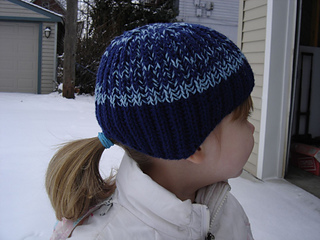patterns > Interweave Knits >  Interweave Knits, Fall 2005 and 2 more...
Interweave Knits, Fall 2005 and 2 more...
> Brioche Helmet Hat




Brioche Helmet Hat
Interweave SKU: EP0028
Pattern Description from Interweave Knits, Fall 2005:
A scientific excursion to research the arctic ice cap of Greenland gave Kelly Bridges the idea for this thick, ear-hugging hat. In preparation for the cold and wind, many of the men in her group brought along earflap hats, but they refused to fasten the ties under their necks for fear of looking girly. Kelly discovered a solution in brioche stitch--its natural tendency to cup the ears without ties looks great on men, women and kids. For extra warmth, she’s worked this hat with a double strand of alpaca. It’s done in the round from the bottom up, and the earflaps are shaped with short rows.
Finished Size: 16 (18, 18)“ (40.5 [45.5, 45.5] cm) circumference and 6 (6½, 7)” (15 [16.5, 18] cm) long from top of base of earflap. To fit 6-12 months (1-2 years, 2-4 years).
Yarn: Frog Tree Alpaca Sport Weight (100% alpaca; 130 yd [119 m]/50 g): 1 ball each of MC and CC. Hats shown in #31 blue (MC) with #30 pale blue (CC), and #205 rose (MC) and #95 pink (CC)
Needles: Size 6 (4 mm): 16” (40-cm) circular (cir) and set of 4 double-pointed (dpn). Adjust needle size if necessary to obtain the correct gauge.
Notions: Markers (m); tapestry needle.
Gauge Note: As an aid to counting the sts and rows/rnds when checking gauge in brioche stitch, count each column of knit sts at 2 sts, and count each knit st in the column as 2 rows/rnds.
Originally Published: Interweave Knits, Fall 2005
Notes:
- The earflaps are worked separately back and forth in short rows after the initial cast on and set-up row. When the earflaps have been completed, work continues in the round to the end.
- Because this project is worked with two strands of yarn held together, take particular care to insert the needle into both strands, and not accidentally split the doubled working strand into two separate stitches.
- When counting stitches, count each slipped stitch and its companion yarnover as one stitch. In other words, do not count the yarnovers at stitches themselves.
- Each yarnover appears to “straddle” its companion stitch, which should make it easy to identify them as a pair to be worked together on the next round. If you are having difficulty knitting or purling a yarnover and stitch together, make sure that you are trying to work the yarnover together with the correct stitch. Spreading the stitches out along the needle can help align the yarnovers with their respective mates.
- Make sure that you don’t accidentally drop any yarnovers that occur at the end of a needle.
- Because the slipped stitch-yarnover pairs alternate position from round to round, when one round ends with a slipped stitch-yarnover pair, the following round will begin with a slipped stitch-yarnover pair. The result is that there will be two slipped stitch-yarnover pairs next to each other at the end-of-round marker. Be sure to bring the yarn all the way around the needle and to the front of the work for the first yarnover so that each slipped stitch will have its own separate yarnover.
- When working a k3tog decrease, you will knit together 5 actual loops on the needle: 2 knit stitches with their companion yarnovers, and the purled stitch between the knit stitch/yarnover pairs.
- The earflaps are set slightly toward the back of the hat, with less distance between them at the nape of the neck than at the front of the forehead; they are not exactly centered on each side of the hat.

5694 projects
stashed
5881 times
- First published: July 2005
- Page created: May 21, 2007
- Last updated: July 30, 2024 …
- visits in the last 24 hours
- visitors right now






